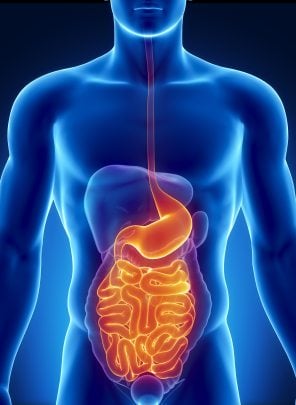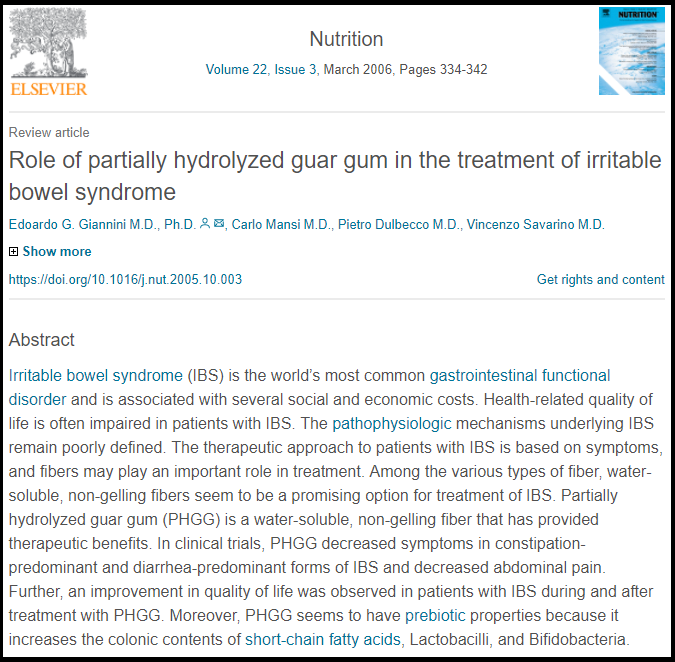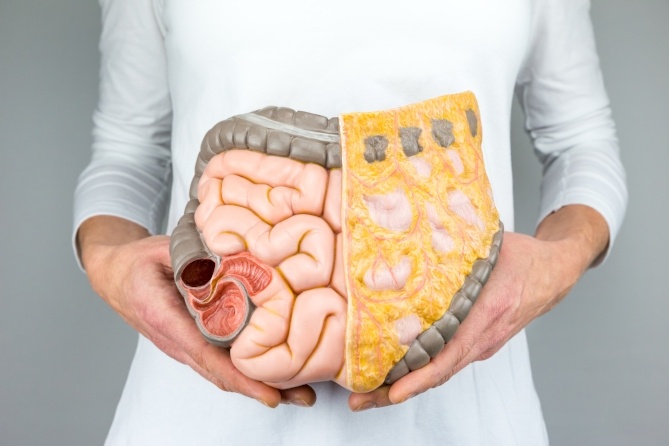As much as I love probiotics, prebiotics like partially hydrolyzed guar gum (PHGG) are just as important.
First, I’ll tell you why probiotics have limitations, and what types of probiotics I use to overcome those limitations.
The other strategy to maintain probiotics and to avoid the limitations of probiotics is to use prebiotics like PHGG.
What are Prebiotics?
Prebiotics are starches and fibers found in vegetables, fruit, roots, and tubers.
When we digest them, they are fermented by our gut bacteria provide fuel for our intestines, and support the growth of other probiotics – providing us with wide-reaching health benefits along the way.
The first reason I love prebiotics is that Nature never intended for us to supplement with probiotics like Lactobacilli and Bifidobacteria
Say what?
Let me explain…
How Nature Promotes Healthy Bacteria
We get our first batch of gut bacteria when we travel through the birth canal and get our first major dose of microbes. The vagina is rich in Lactobacilli and this seeds our gut and body with its first probiotics.
We feed, maintain, and add further probiotic diversity as infants by consuming breast milk.
We also get immune stimulation, modulation, and protection from the diverse immune factors in breast milk. Breast milk contains “custom-made” support that you cannot replicate in a bottle of formula.
Those born via C-section and who are formula-fed at birth do not receive much of these benefits.
So while they may catch up later (and live generally healthy lives), birth history and infant feeding has been implicated in why some individuals are at more risk for allergic and autoimmune problems later in life.
C-sections can be unavoidable. Not every woman is able to breastfeed, nor are women always able to breastfeed exclusively for 6 months as recommended.
Exposure to even a single round of antibiotics, and even a single bottle of formula, may call a need for probiotics and prebiotics at any age, independent of how you were born or fed early in life.
When it comes to C-sections, some health professionals are implementing “seeding” practices for babies born via C-sections. Seeding is when the mother’s vagina is swabbed to borrow the healthy bacteria, and then the swab is applied to the mouth, eyes, and body of the baby.
Others are using probiotic and prebiotic strategies to support a healthy gut for their baby to compensate for any breastfeeding limitations they may have encountered.
The infant’s gut is non-acidic – allowing the safe passage of probiotics. This allows babies to establish healthy microbes in and around the body. It also allows us to receive immune stimulation and protection from our mothers.
Much of my work as a clinician is helping clients reestablish intestinal health – stemming back as early as their birth history, antibiotic history, and more.
While health problems may not manifest until their mid-twenties or later – they are rooted in the health of the gut from the beginning.
So let’s talk about therapy with probiotics and prebiotics like PHGG.
Limitations of Conventional Probiotics (Lactobacilli, Bifidobacteria, etc)
 As a baby matures, weans off breast milk, and prepares for solid food, the gut acidifies.
As a baby matures, weans off breast milk, and prepares for solid food, the gut acidifies.
The acidifying of the stomach is Nature’s way to protect the infant from potential pathogens from the food and the environment.
After this point, conventional probiotics like Lactobacilli and Bifidobacteria are not making it through the gut alive as they are killed by the stomach acid.
This is why I recommend soil-based spore probiotics like SporeBoost IgG and Megasporebiotic. Spores are virtually indestructible and make it through the acidic environment of the stomach without problems.
Once in the gut, soil probiotics provide immune stimulation, modulation, and crowding out of bad bacteria. They also help us digest and extract nutrients from foods and create vitamins, short-chain fatty acids, and other substances that our bodies use independently of our own food intake.
Spore probiotics are also self-sufficient – they don’t require prebiotics to grow. They make it through the stomach as spores, germinate in the small intestine, do their thing over 7-21 days in the gut, form spores again, and are excreted back out.
Nature does expect that we would be interacting with dirt regularly. We live in very clean and sanitary environments in the Western world and is why so many people tend to respond well to regular supplementation with spore probiotics like Megaspore.
Healthy levels of soil organisms require regular inoculation from breathing in and being around dirt.
No dirt? Supplementation is the next best thing.
Health Effects of Probiotic Deficiency
When you lack healthy bacteria, unhealthy bacteria take their place. This imbalance of bacteria is generally called “Dysbiosis”.
This is why many gut-rebuilding strategies start with natural antibiotics like monolaurin which kill or slow the growth of a wide range of organisms, while also leaving healthy ones alone. I use monolaurin pellets from Inspired Nutrition.
Probiotics also help by producing their own antibiotic and anti-yeast compounds – while also competing against the bad guys for resources and physical real estate in the gut.
In addition to Megaspore, I recommend TrubifidoPRO to start, then with tolerance, TheralacPRO
Both products have a special way that they protect Lactobacilli and Bifidobacteria probiotics through the stomach acid and bile acid of the early digestive tract.
1.) Most people do not interact with dirt – and so aren’t getting the immune benefit of soil-based probiotics
2.) Most people have been on an antibiotic at least once in their lives.
3.) Most people do not eat nearly enough fruits and vegetables to properly support Lactobacilli and Bifidobacteria either. (Nor are they eating a high diversity of vegetables when they do eat fresh foods)
Most probiotics do not make it through the gut alive unless there’s a significantly high dosage (as well as proper storage, transport, and dose overage to account for some loss).
You may not be getting the full benefit you expect. A “good probiotic’ can (and should) cost you $70 and more for a month’s supply. Sporeboost IG, Megaspore, TrubifidoPRO, and TheralacPRO can be cost-effective when you consider the bio-available dosage you’re getting for the money.
Why Do Traditional Probiotics Still Seem to Work?
The benefits experienced by other probiotics come from the immune stimulation triggered by dead probiotic cells.
Yes, dead probiotics can still stimulate and modulate the system while they transit through the digestive system.
Professional products tend to carry enough dosage that despite when 50% or more of the probiotics are killed in the gut (some still make it alive) – but at $70+ a bottle – you are getting a compromised dosage.
Probiotic benefits tend to be transient – they help as long as you continue to take them. When you stop taking the probiotics, you stop getting the benefits too. If true “recolonization” was happening – you’d expect better longer-term outcomes.
Fermented foods are widely touted for their benefits (kefir, yogurt, kimchi, kombucha). These probiotics can be “live” in the food, but still will be killed by stomach acid. It is believed that we experience benefits from these foods because of the unique vitamins and healthy byproducts of fermentation.
Of course, some dosages will still make it through too like the case with high-quality probiotics. This is good, so that your probiotic expense isn’t a total waste, just know what you’re paying for in advance and you might find other brands to be cost-effective for the dose actually being delivered to the gut.
What many professionals miss is that long-term recolonization eventually requires maintenance from dietary or supplemental prebiotics, like partially hydrolyzed guar gum (PHGG).
The live organisms that do make it to the intestines, will still require prebiotic fibers like PHGG to feed them long-term.
The higher the diversity of plants that you consume, the more prebiotics you consume, and the broader range of microbes you can support and maintain.
I use Sunfiber Powder and Trufiber (also from Master Supplements) as my sources of PHGG. When I want to diversify my prebiotic sources more, I use Floraspectrum Prebiotic Powder by Doctor Alex Supplements to add more diversity (it contains three of the most studied prebiotics – inulin, beta-glucan, and larch arabinogalactan).
Both prebiotic products can still be helpful in their own ways as the more diverse the prebiotic “fertilizer” is – the more variety of microbes being supported.
With any probiotic or prebiotic strategy, the goals are
1.) Make sure your strategy is working (are they making it through the gut at relevant dosages?).
2.) Promote as much diversity as feasible by your diet, food availability, and budget.
The more diversity that’s present in your gut microbiome – the healthier your immune system, metabolism, brain health, mood, sugar regulation and more!
Diversity allows your body to respond to a diverse range of health needs as they come up in your life.
If you have a unique health need, would you rather have 300 ways to respond? Or 30 ways?
That’s how diversity works.
This is why I love PREbiotics like PHGG (or PhytoFlora Microbiome Support as a unique and well tolerated addition) just as much as I recommend probiotics like SporeBoost IG, Megaspore, TrubifidoPRO, and TheralacPRO.
They are necessary to promote the growth of Lactobacilli and Bifidobacterium and other probiotics – as nature intended in the first place!
I personally supplement with Megaspore and Sporeboost IG on a regular mix and match basis, and rotate Theralac, TruFlora, and TrubifidoPRO to add more diversity with traditional strains that I know are making it through the gut based on their special delivery systems.
To maintain and support even more diversity I will also mix and match between Sunfiber, PhytoFlora, and FloraSpectrum right before bedtime. I offer a Prebiotic Diversity Trio which contains one bottle of each for less.
I like taking them at night to promote the growth of bacteria best when fasting overnight (16-hour intermittent fasting is optimal).
I also look for unique fruits and vegetables of different colors and varieties to deliver unique phytochemicals and fibers for my bacteria to enjoy.
Treat your microbes as your beloved pets:
Treat them better than you treat yourself, you wouldn’t willingly hurt them, and you routinely get them different toys to play with!
In return, they love you unconditionally and have health benefits from having them around.
Show love for your intestinal pets :).
What is Partially Hydrolyzed Guar Gum (PHGG)?
PHGG is a prebiotic that mixes well in water, is broken down, and is turned into healthy stuff by bacteria in the colon, and it doesn’t get gummy, thick, or gelatinous, so it’s not going to bind you up like other fibers. It also has little to no taste – so it can be easily added to water, food, and smoothies.
Easy peasy, right?
The low viscosity gives it a pleasant texture and it can be added directly in feeding tubes – which is very valuable for critical care nutrition (tube feeding, liquid diets, diarrhea in bed-ridden patients, etc).
But you don’t need to be in a critical care state to enjoy its benefits.
Partially Hydrolyzed Guar Gum vs. Guar Gum
It’s important to recognize the differences between PHGG and guar gum.
Guar gum comes from guar beans which are raised predominantly in India. The main prebiotic starch found in guar gum is glucomannan.
The bacteria in your colon will ferment glucomannan into intestinal fuel called short-chain fatty acids (SCFAs) like butyrate, propionate, and acetate. These SCFAs provide wide-reaching benefits for gut and immune health.
PHGG is derived from guar gum and contains glucomannan, yet has some different properties.
Both PHGG and guar gum will promote the production of healthy SCFAs, but PHGG is better tolerated and arguably safer to use as a supplement. SCFA production can also be promoted with probiotics and can be taken directly as a supplement. We use SCFA capsules or Sunbutyrate TG by Pure Encapsulations too to jumpstart the process!
Guar gum is often used as a thickener and stabilizer in sauces and other food applications. This thickening can also happen in your stomach and gut too.
Guar gum is viscous and will swell with water and create gels and cause thickening of solutions. This can be too much for those with constipation or who are at risk for intestinal blockages. PHGG is much less viscous than guar gum.
A weight loss product called Cal-Ban 3000 contained guar gum as a primary ingredient. It led to multiple instances of esophageal and intestinal blockages – and contributed to one death when a patient had a blood clot during surgical removal of guar gum capsules that swelled and obstructed their esophagus.
PHGG has different properties than the form used in Cal-Ban 3000 and should not be confused!
So while guar gum is generally safe in the amounts found in commercial foods – it can still be problematic as a supplement. Some clients with intestinal problems find benefit from removing guar-gum-containing foods – even when the presence in foods is relatively small.
It is important to bring this up because PHGG is different.
PHGG does not have the “viscous” or swelling properties of guar gum. These properties minimize uncomfortable side effects while still offering prebiotic benefits.
Partially Hydrolyzed Guar Gum Benefits
Fibers help modify bacteria in the gut and help stimulate the growth or function of beneficial microbes.
Imbalances of microbes are implicated in inflammatory bowel diseases like Ulcerative Colitis and Crohn’s disease, and also Irritable Bowel Syndrome (IBS).
IBS affects 10-15 % of the United States population and is associated with abdominal pain along with irregular bowel movements. It predominantly affects women and most commonly between the ages of 30-and 50 years of age.
Fermentation of prebiotics produces short-chain fatty acids (SCFAs) which are attributed to the wide benefits of fermentable fibers like PHGG.
Much of the benefit of partially hydrolyzed guar gum is due to the prebiotic nature of feeding bacteria like Lactobacilli and Bifidobacteria and being fermented into SCFAs (1).
Here’s what the literature says about PHGG:

- PHGG improves symptoms for both constipation-dominant and diarrhea-dominant IBS. While benefits can be found for other prebiotic fibers too, patients routinely report a preference for PHGG over other prebiotic sources. (2; 3; 4; 5; 6)
- May also help constipation as it mildly boosts bowel frequency, fecal moisture, and the presence of Lactobacilli species (7).
- Supplementation improves IBS symptom frequency, while the same benefit is not always apparent for other fiber supplements (8)
- PHGG reduced laxative dependence in a nursing home population and may help with diarrhea associated with tube-feeding (9), and septic patients (10; 11).
- PHGG is also popular in SIBO treatment. A 2010 clinical trial demonstrated that when PHGG was recommended alongside rifaximin (a pharmaceutical antibiotic), SIBO eradication outcomes were even better than just rifaximin alone (12).
I use the Sunfiber form of PHGG and often transition to TruFiber. Trufiber contains a small amount of inulin – and it can be a useful “bridge” product to other prebiotics for someone slowly advancing their dysbiosis protocol to involve more diverse prebiotics.
Other Health Benefits of Partially Hydrolyzed Guar Gum
Water-soluble fibers will still delay digestion, and affect how bile and cholesterol are absorbed and produced by the body.
There are a lot of research papers on guar gum with these benefits (it is more viscous and absorbs more water than PHGG).
Despite being much less viscous, you are still getting these benefits to a degree when consuming PHGG.
- Support of healthy transit time of food and wastes through the colon, stimulation of the satiety hormone cholecystokinin, and longer perception of satiety after eating (13).
- Reduced absorption of bile acids, forcing the body to convert more cholesterol into bile acids – reducing cholesterol formation, as well as uptake of LDLs (“bad” cholesterol).
- Inverse relationship with cardiovascular disease (14; 15).
- Less risk of discomfort, and, while relatively rare, less risk of esophageal and intestinal blockages. Most reported side effects may include abdominal discomfort, gas, diarrhea, and cramps (16). Again, these symptoms would be much less with PHGG than with guar gum. Patients tend to prefer PHGG over other fiber types as they enjoy the health benefits with less risk of discomfort. PHGG is certified as FODMAP-safe by MONASH University, the creators of the FODMAP diet, in support of its
Remember to start low and work your way up with ANY probiotic or prebiotic strategy.
Unique circumstances can change the type and amount of probiotics/prebiotics you take so check with your health professional on what’s right for you.
It can be useful to directly help rid overgrowth via natural antibiotic compounds and, occasionally, pharmaceuticals like rifaximin at least at the beginning of a gut program.
I like Biocidin which comes in liquid, capsule, and liposomal forms to help support a normal balance of flora early in a protocol.
I’ve also outlined the 7 main leaky gut support strategies for review.
Probiotics and prebiotics like PHGG can be essential adjuncts to crowd out bad bugs, replace good ones, and sustain the changes long-term.






